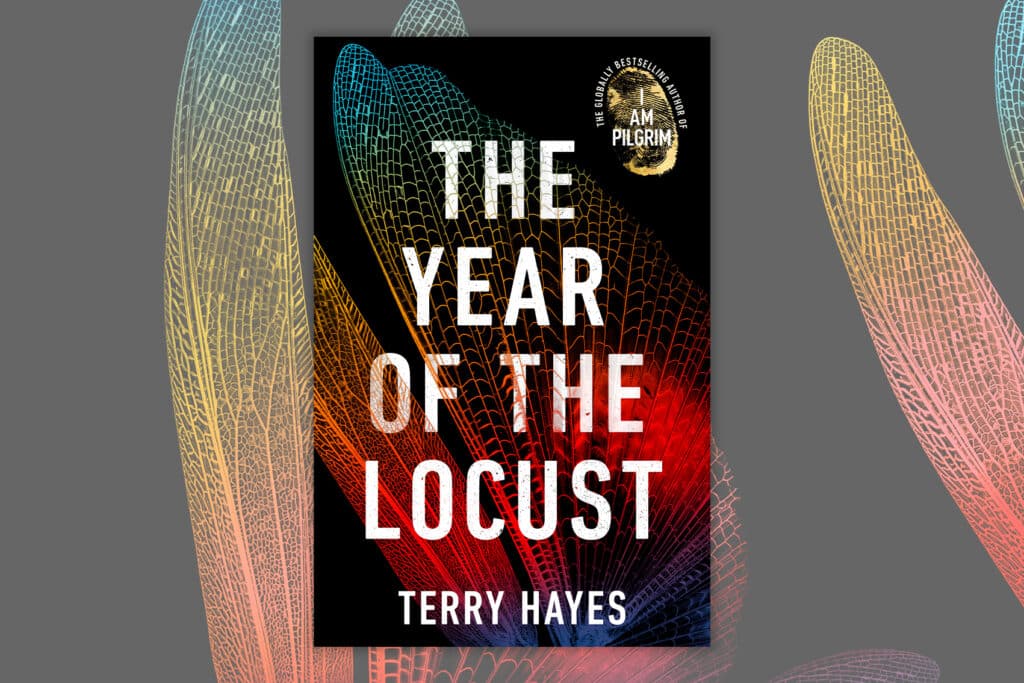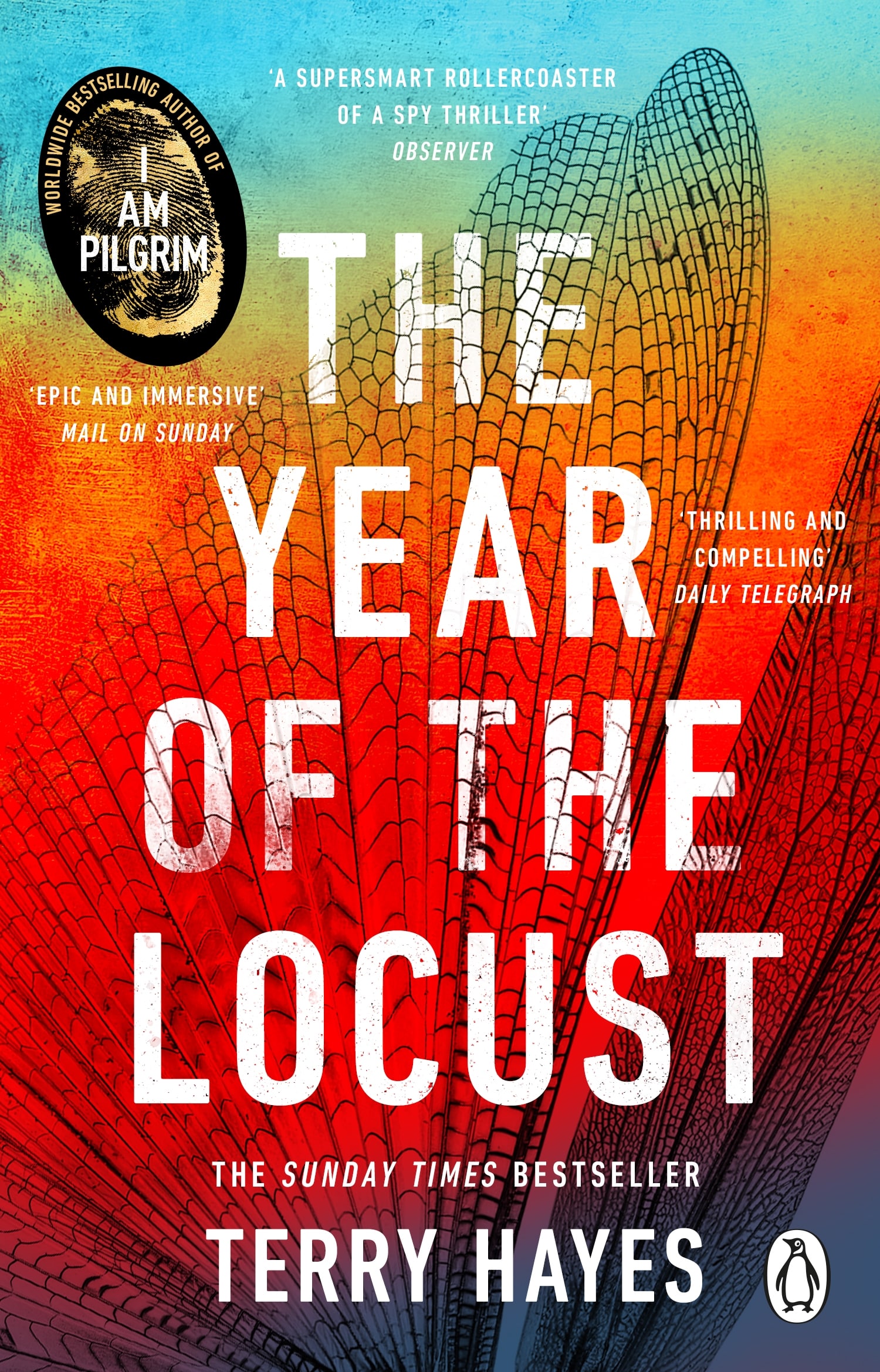Extracts
Extract: The Year of the Locust by Terry Hayes
I Am Pilgrim by Terry Hayes has been one of the biggest thrillers of recent years.
This incredible novel got us all talking, and like many readers we’ve been desperate for a second dose of Terry’s writing.
But now our wishes have finally been answered! Terry’s long-awaited second novel, The Year of the Locust, will publish on 9 November 2023.
We’ve got an exclusive extract here for you now – read on and let us know your thoughts in the comments below…
The Year of the Locust
by
Terry Hayes
Chapter One
I once went to kill a man. At other times, in younger days, I had followed my work through the neon-lit alleys of Tokyo, watched the sun rise over the Mosque of the Nine Cupolas and waited on the waterfront in Old Istanbul as a woman’s tears fell like rain.
This time, it was way out east where the Aegean Sea runs into the Mediterranean and the Turkish sun beats down on a chain of tiny islands. The smallest of them was also the most remote – waves broke over the wreck of a freighter lying on a reef, dangerous currents swirled through hidden coves, and a fishing village, its wooden boats long gone, was nothing but ruins now.
I landed in late spring, put ashore by the Egyptian skipper of a tramp steamer who was wise enough not to ask many questions. I can still recall the breeze on my face and the heady scent of pine needles as I moved through a silent forest; as I have done for most of my working life, I stuck close to the shadows.
My target that day was a brave man, no doubt of it, supposedly a German out of Nuremberg – that beautiful old city steeped in so much dark history – and when I surprised him in the kitchen of his lonely villa, we both knew I had travelled a long distance, both in miles and in years, to arrive at such a deadly rendezvous.
I was a member of the agency back then and, five years earlier, the German had been a trusted asset of US intelligence in Tehran. What nobody knew, but found out soon enough, was that he was secretly working as a contractor for the Russians. It seems like everything is being outsourced these days, even espionage.
On a quiet Monday night he had gone for a late meal in the bistro at Tehran’s gilded Espinas Palace Hotel and in the men’s room had delivered the names of ten of our most valuable Iranian sources to a representative of Moscow Central. It is well known in the secret world that the spy agencies of Russia and Iran have worked hand in glove for years, so it was inevitable that the list of names would end up with PAVA, the brutal Iranian secret police. As a result, our network – built over many years at a huge cost in lives and treasure and, more importantly, a vital back door into the Iranian nuclear programme – was destroyed within hours. Even for the CIA, an organization that had known its fair share of failure, it ranked as an unqualified disaster.
The consequences for the eight men and two women who were unmasked as a result of our asset’s betrayal were far more catastrophic. They appeared before a judge in a late-night trial and the next day workmen started to assemble ten towering construction cranes in one of Tehran’s largest squares. While members of the public didn’t pay much attention at first, their purpose soon became clear: it was to ensure that as many people as possible could witness the court’s sentence being carried out. In many countries in the Middle East it is not enough that people are punished; everybody else must be warned.
Once the towers had been erected, the horizontal arms were attached. Coils of rope were fixed to the end of the jibs and late on a spring day four black prison vans brought the captives to the square. One by one, as the minutes crawled by, each of them was conveyed in a cage to the top of their own personal crane.
There, under the gaze of the crowd gathered below, Revolutionary Guards forced the terrified men and women on to a small platform at the end of the jib. They hung a sign on each prisoner’s chest identifying them as a spy for the ‘Great Satan’, and a noose, popularly known in the country as the ‘Iranian necktie’, was then dropped over their head.
Thanks to the careful planning, people packed in the square were all afforded an unimpeded view of the ten figures above them. Against a clear blue sky, they seemed to be suspended between heaven and earth. Given the circumstances, I suppose that was exactly where they were.
A small huddle of men and women closest to the cranes – most likely relatives and friends – were on their knees, wailing and praying. They looked up as a uniformed man, a lieutenant colonel, climbed on top of one of the vans and spoke in Farsi through a loudhailer, his voice echoing across the square. He read out the name of each prisoner, the charge and then the sentence.
Finally, he lowered the pieces of paper and, more loudly, said a word which translated as: ‘Ready.’ One of the condemned prisoners – a man – heard the word and his courage failed: he screamed, calling on God to save him.
As usual, at least in my experience, such a plea had no apparent effect. In a well-practised routine, the Revolutionary Guards stepped forward and each placed their right hand on the small of a prisoner’s back.
At this gesture, a heavy silence fell across the crowd, and a child, a boy aged about six, stood up from among the group of friends and relatives and stared up at one of the prisoners – possibly a mother or father – and started calling out a name. A woman beside him pulled him back down, the boy started to cry, and after what seemed like an eternity the man with the loudhailer gave the next order: ‘Now.’
The Guards, in unison, pushed the prisoners forward. Ten pairs of feet left the wooden platforms and an involuntary gasp went up from the crowd. The relatives and friends watched shoes and sandals rain down as the victims fell through the air.
Plunging feet first towards the square far below, the coils of rope reeled out fast behind them. When the coils ran out, the ropes snapped hard against their anchors, the nooses tightened around ten throats, the prisoners jerked upwards, and their necks snapped in an instant.
Nobody in the crowd said a word; the only sound was the wailing of the families as the ten bodies swung gently in the warm Middle Eastern breeze.
I wasn’t surprised that the crowd had reacted with silence. It has been my misfortune to witness a number of executions – several by firing squad, two by hanging and one when an elderly man had been strapped into an electric chair and forced to ‘ride the lightning’, as the guards on death row call it – and I can promise you: the terror on the face of a man or woman as everything they had hoped to be vanishes into eternity never leaves you. The memory of it will surface at 3 a.m. when everything you fear most in the world is on its way, coming up the stairs to find you.
Several days earlier – in the Espinas men’s room – the German, in payment for the list of names, had received an attaché case containing a fortune in anonymous Swiss bearer bonds. I’m not a believer – nobody could ever say that about me – but two thousand years ago St Paul wrote something that, once heard, is not easily forgotten: the love of money is the root of all evil. It certainly was that night in Tehran.
From the moment the traitor had left his coffee cup, an old raincoat, two cigarette butts and a crumpled credit card receipt on the table in the bistro, entered the bathroom, made the exchange, exited via an adjoining cigar bar, swung on to the back of a waiting motorcycle taxi and vanished into the city, the agency’s analysts estimated that ninety-two seconds had elapsed. Ninety-two seconds to turn yourself into a multimillionaire, destroy an entire intelligence network and sign the death warrants of ten colleagues. By any measure, he was a very good spy. As a self-taught freelancer, he was out of the box.
As you would expect, the CIA – the deeply flawed but occasionally brilliant organization where I had worked for the previous twelve years – made numerous attempts to find him, but none of them came close to success and, with more evidence of his double-dealing surfacing daily, his status grew until he became something of a dark legend to US intelligence. Worse still, the agency’s analysts drilled down and found that over the years he had assumed so many fake identities that the Company was finally forced to admit one final chilling fact: they had no idea who he really was. Maybe he wasn’t even German.
With his real identity a mystery – and, I suspect, out of respect for his impressive vanishing act – one of the agency’s resident intellectuals gave him a name that soon took flight. She codenamed him ‘The Magus’, a sorcerer, a magician, a word with roots deep in antiquity. The Bible tells us the three wise men who brought gold, frankincense and myrrh to mark the birth of Jesus were all magi. So, the CIA – the company that throughout its seventy-five-year history had pioneered so many of the dark arts of espionage – had finally met a wizard and a solo operator almost as good as itself.
Needless to say, that realization fuelled the frustration of the expensively tailored man in our corner office and encouraged him to redouble the agency’s efforts to find him. Believe me, there has never been a shortage of testosterone at the highest levels of the intelligence world.
When even the much better-resourced search, led by a hand-picked team of data-miners and elite field agents, could find no trace of The Magus, the problem landed on my desk. It was a Friday and I was heading out for an early lunch – the Starbucks at CIA headquarters at Langley is, by many accounts, the busiest in the world – and I was aiming to beat the midday crush. My computer and floor safe were already locked when I heard the unique tone informing me that a high-priority message had just hit my inbox.
I decrypted it and saw that it contained the secret files relating to the betrayal in Tehran, horrifying footage of the public execution hacked from PAVA’s cameras, and accounts of the string of failed manhunts that had followed. Accompanying it was a note from the director asking me to familiarize myself with the material and meet him in his office just before dawn on Monday. Being called to a meeting at such an ungodly hour by him wasn’t unusual and there were some in the agency who claimed the early appointments were a ploy – he wasn’t a workaholic, they would say, he just liked to create that impression.
As it happened, they were wrong: he was a driven, ambitious man who – though very few knew about it – had grown up in strange and difficult circumstances. Work, I had always thought, filled an emotional void for him and – to be honest – it wasn’t unusual in an agency renowned for its eccentrics and misfits.
The director – silver-haired and still retaining much of the tall, athletic build that had made him a track star in college – had grown up as Richard Rourke, but nobody had used his given name in years. He was universally known as Falcon – ever since, as a young agent, he had entered Iran as part of a joint US–Israeli team tasked with crippling an array of nuclear centrifuges hidden in the rugged mountains near a town called Natanz.
The mission ended in disaster, but even though Rourke was the least experienced member of the team, he showed not only extraordinary courage but a remarkable coolness in extreme circumstances: at least five Iranians working for the agency ended up owing their lives to him. As word spread through the secret world of his midnight escape, under fire and stopping for nothing, driving across the border into Iraq with half a network of local collaborators in the back of his pick-up, the name Falcon stayed with him.
With arresting eyes and a firm line to his jaw, he was probably more imposing than handsome, but one thing was certain: he was the best-dressed man I had ever met. No matter the hour, no matter how fraught the situation, you would find him early in the morning in his office, or late at night in the operations centre, wearing a hand-made Brioni suit, a silk tie and a Charvet shirt. Even his collection of cufflinks was a wonder to behold.
Once he had left front-line operations, he spent several decades climbing the greasy pole in Washington, and the clothes and the image were all part of that. In the corridors of power and the elite social salons of Georgetown he was seen as both accomplished and very sophisticated; a safe pair of elegant hands.
He was sixty-two years old by the time I received the summons to his office and, to be honest, I wasn’t surprised to receive it. I had heard rumours that the latest search for The Magus was proving to be no more successful than its predecessors and I figured that sooner or later an elite member of US intelligence would realize I probably had the necessary skills to bring a new approach to the pursuit.
By a strange set of circumstances, I was one of a small cadre of spies who specialized in entering what are called Denied Access Areas – places under total hostile control such as Russia and Syria, North Korea, Iran and the tribal zones of Pakistan – so I had more knowledge than most about how someone who was being hunted to the death might evade discovery.
In short, The Magus obviously knew how to hide. And so did I.
The Year of the Locust by Terry Hayes will publish on 9 November 2023 – and if you still haven’t read I Am Pilgrim, now is the perfect time!
4 Comments
Join the discussion
Please note: Moderation is enabled and may delay your comment being posted. There is no need to resubmit your comment. By posting a comment you are agreeing to the website Terms of Use.



Why are the preview chapters of the year of the locust at the end of a recent paperback print of I am pilgrim different from the ones at the start of the nrw published the year of the locust?
Almost a decade later, the second book. At this point, do I care? To be honest, not much. This is a decent intro, but I now have so much negativity connected to this book, I’m not sure I’ll pick it up. Maybe when it turns up in a charity shop I’ll give it a go.
Been waiting for this to finally appear since I finished the locust what 5 years ago looks like the wait was worth it rill on November 2023
This book I thought was fantastic, it was thrilling, & gripping, I basically couldn’t put the book down, I’m waiting for the next book to be published, this book was hot, I recommend it to anybody, it was a very good read, hope the next book will be just the as good.